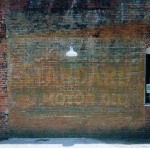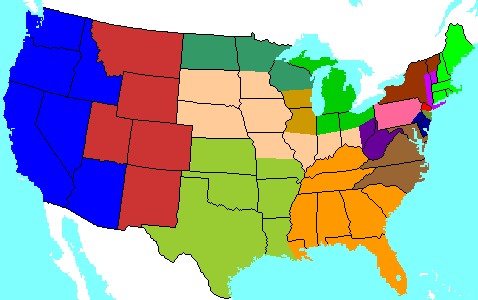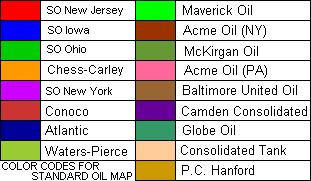 Whatever
Happened to Standard Oil? Whatever
Happened to Standard Oil?
A highly abridged
history of the petroleum companies that have used the
"Standard" brand name.
John D. Rockefeller's Standard Oil Trust is one of the
most famous industrial organizations ever. The Trust
controlled a lion's share of the production, transport,
refining, and marketing of petroleum products in the
United States and many other countries. Originally, this
Trust was an attempt to cash in on the lucrative home
lighting market which was converting from whale oil to
kerosene. The emergence of the automobile and its thirst
for the formerly near worthless refining by-product
called gasoline brought dizzying wealth to this
industrial group. The 1911 decision to break up the Trust
had the result of making the seperate pieces more
valubale than the whole was, and stock prices rose
sharply. When he was informed of the US Supreme Court's
descision to breakup of Standard Oil, Mr. Rockefeller
turned to his golfing partner and said, "Father
Lennon, have you some money?" And the priest was
very startled by the question and said, "No."
And then he said, "Why?" And Rockefeller
replied, "Buy Standard Oil." (1)
The break up of Standard Oil mirrors a more modern
monopoly breakup - AT&T - a.k.a. The Bell System,
"Ma Bell". Both developed ubiquitous brand
names: Bell for telephone service, Standard
for oil. Like the "Baby Bells", many of the
"Baby Standards" kept the old company identity
as they went into business for themselves. Unlike the
various Bell companies, they were restricted from using
Standard name in each other's territory. They defended
the exclusive territorial rights to the name vigorously.
Both fractured entities rose again to dominate the market
and became more valuable than the original parent. More
Standard Oil Companies were created as some successor
organizations declined to use the venerable Standard name
in favor of pre-trust identities and the other Standards
expanded into those marketing areas. As national
advertising and travel blossomed, the various Standards
ended up in competition, often adopting the names of
smaller oil companies they had purchased. The goal of
this site is to track the history of the Baby Standards,
discovering what became of Rockefeller's petroleum
powerhouse.
|
 |
If you want to find out what became of Ma
Bell, check
out this link. The breakup and reconsolidation has
happened on a much faster time table than Standard's. The
old '69 Bell logo is still in use, at least by Verizon in
a secondary manner on some of thier remaining pay phones.
No word on Qwest,
though they have a swoop logo in advertising and I can't
recall ever seeing them use the Bell. The new at&t is led by SBC
(Southwestern Bell) after having absorbed Pacific
Telesis, then purchasing the remains of AT&T.
BellSouth was also absorbed by SBC. BellSouth made
extensive use of the old Bell logo before the merger. Now
they use the at&t "Death Marble" adaptation
of the AT&T "Death Star" logo. Verizon's Bell logo is
red or white on a red background. Cincinnati Bell
quit using the classic bell in 2005. If the Bell company
consolidation was the pattern for Standard Oil Company
consolidation - Sohio (Cincinnati Bell) would still be
independent, ExxonMobil would be Verizon (Exxon =
BellAtlantic + Mobil = Nynex) and Chevron (SBC / Pacific
Telesys) would have purchased Amoco (Ameritech), then
finally turned and purchased KYSO (BellSouth). If the
Bell reconsolidation had mirrored Standard Oil's: SBC/
Pac Tel would have bought BellSouth early on. British
Telecom would have bought Sohio. BellAtlantic and Nynex
would have merged. Lastly, British Telecom would have
merged with Ameritech, told everyone they were changing
thier name to Ameritech for US operations, then changed
thier minds and used "bt" - Beyond
Telecommunications. |
| |
| |
Click HERE
for answers to some Frequently Asked Questions

Before the Trust breakup, there
were other Standard Oils. You need a timeline of Standard's
history to understand what happened to them.
- 1868: Standard
Oil Company (Pittsburgh, Pennsylvania) is
organized. This was the first Standard Oil, successor to
the South Improvement Company.
- 1870: The
Standard Oil Company is incorporated in Ohio.
This would later become Sohio, and was the leading
organization in the Trust for many years. Gilbert & Barker
Manufacturing (modern Gilbarco) organized in Massachusetts
- 1873: Ohio Standard purchases
50% of Chess, Carley & Company
- 1874: Atlantic
Refining (est. 1866 as Atlantic Petroleum Storage
Company) is added to the Standard alliance.
- 1875: Acme Oil Company
and Camden Consolidated Oil Company join the
Standard alliance.
- 1877: The
Standard Oil Company of California (Ventura)
formed by local businessmen in Ventura County,
California, hoping for a future connection to the eastern
company; Baltimore United Oil Company formed of
parts of many smaller firms, including Camden
Consolidated.
- 1878: Waters-Pierce Oil
Company (formerly H.C. Pierce & Company) and Consolidated
Tank Line Company (Cincinnati) came under the
influence of the Trust.
- 1879: The
Standard Oil Company (Ohio)'s marketing area
included Ohio, Indiana, Illinois, Wisconsin, Michigan,
the Rocky Mountain States, and California. Vacuum Oil
Company (est. 1866) added to the Trust. Pacific
Coast Oil Company acquired The Standard Oil Company
of California (Ventura).
- 1880: Imperial
Oil of Canada founded.
- 1881: National
Transit Company formed to own and operate
pipelines.
- 1882: Standard
Oil Company of New Jersey ("Standard")
was formed to take advantage of New Jersey laws that
allowed corporations to own stock in other corporations.
It provided adminstrative coordination to the Trust. Standard
Oil Company of New York also formed this year,
and administered most of the foreign territories. The
West India Oil Company formed to handle refining in
Cuba & the Caribbean.
- 1883: Standard of
Ohio's midwestern marketing area was acquired by P.C.
Hanford Oil Company, a Standard afflilate; McKirgan
Oil Company (Newark, NJ) incorporated by Standard,
was part of Acme (NY)
- 1884: Continental
Oil (est. 1875 as Continental Oil and
Transportation Company) was acquired by the Standard
alliance to handle distribution in Colorado, Montana,
Utah, Wyoming, and New Mexico. Gilbert & Barker
acquired by the Standard Oil Trust.
- 1885: Standard
Oil Company of Iowa was formed to handle
marketing along the Pacific coast. Solar Refining
Company formed. Buckeye Pipe Line formed.
Standard's Vacuum Oil opened a marketing office in
Liverpool, England.
- January
1, 1886 - Standard
Oil Marketing Map


- 1886: Standard
Oil Company of Kentucky was formed to absorb the
assets of Chess, Carley, & Company. Also, Standard
Oil Company of Minnesota was formed to absorb Bartles
& Richardson in Wisconsin, Minnesota, North
Dakota and South Dakota. Remaining assets of The
Standard Oil Company of California (Ventura)
liquidated.
- 1887: Ohio Oil
Company formed; Globe Oil (Minn) purchased
- 1888: Anglo-American Oil
Company, Ltd. formed; Continental Oil acquires an
interest in United Oil of Colorado; McKirgan
Oil Company purchased by Jersey Standard; The first
all steel tanker, the Standard,
built for Socony.
- 1889: Standard
Oil Company of Indiana was formed, centered
around the Whiting, Indiana refinery. It was only in the
production end of the oil business. The Ohio Oil Company
was purchased by the Standard Trust, its only customer. South
Penn Oil Company was formed to explore and produce
oil in Pennsylvania and West Virginia.
- 1890: The Trust
purchased the remaining shares of P.C. Hanford and
transferred its assets to the newly formed Standard
Oil Company of Illinois
- 1892: Due to court
action by the State of Ohio, the Standard Oil Trust
officially dissolved. Jersey Standard becomes the
controlling organization for Standard. Indiana Standard's
capitalization soared when it separated from Ohio
Standard. It purchased and absorbed Illinois Standard,
Minnesota Standard, & Globe Oil (Minn) gaining a
midwestern marketing arm. Standard Oil Company
(Pittsburgh, PA) & Acme Oil (PA) absorbed by Atlantic
Refining. Standard Oil of Kentucky absorbed Consolidated
Tank Line. Standard Oil of New Jersey absorbed Baltimore
United Oil, Camden Consolidated Oil, & Eagle Oil.
Standard Oil of New York absorbed Acme Oil (NY) &
Maverick Oil; outside of the US, Socony opened an office
in Shanghai, China.
- 1893:
Socony opens an office in Yokohama, Japan to sell
kerosene, Vacuum Oil opens an office in Kobe, Japan to
sell lubricants.
- 1895: Standard enters
the promising Kansas oil fields under the name Forest
Oil buying out Guffey & Galey
- 1896: Indiana
Standard purchased the marketing rights to Iowa,
Nebraska, Kansas and Missouri from Kentucky Standard. (The)
Standard Oil Company of Kansas and Standard
Oil Company of Missouri organized due to
anti-Standard sentiment in those states. SO (Kan.) was
only a refining concern.
- 1897: Empreza
Industria de Petroleo organized in West Virginia.
- 1899: Indiana
Standard purchased Ohio Standard's remaining eastern
Michigan and eastern Indiana marketing areas. Standard Oil of Missouri dissolved; Socony
decides to open an office in Hamburg, Germany.
- 1900: Pacific
Coast Oil Company (est. 1879) was purchased by
Standard Oil.
- 1901: Republic Oil
formed to 'compete' with Standard by Standard
stockholders, operating in secret. Galena-Signal Oil
Company formed by merging of Galena Oil and Signal
Oil. Kansas Oil & Gas Company absorbed the assets of
Forest Oil. Later that same year Prairie Oil & Gas
Company, another Standard company, absorbed Kansas Oil
& Gas.
- 1902:
Vacuum Oil opens an office in Alexandria, Egypt.
- 1905: Jersey Standard acquired
Carter Oil, Marion Oil, Washington Oil, Crescent Pipe
Line, and South-West Pennsylvania Pipe Lines from
National Transit
- 1906: Standard
Oil Company of California was formed to take over
the Pacific coast marketing area of Pacific Coast Oil and
Iowa Standard. Iowa Standard was liquidated prior to the
Trust breakup, despite being mentioned in court papers.
Also that year, Standard Oil Company of Nebraska
was formed from Indiana Standard assets in response to an
anti-monopoly campaign in that state. Republic Oil was
dissolved and its assets sold to Indiana Standard, Ohio
Standard, and Waters-Pierce.
- 1908: Chesebrough
Manufactuing Company (est 1875) added to Standard
Oil.
- 1909: Standard Oil
Company of Louisiana organized by Jersey
Standard. Navarro (Corsicana) Refining Company
& Security Oil Company were severed from
Standard in a Texas court decision. Manhattan Oil Company
absorbed by Anglo-American Oil Company
- 1910: Standard Oil
Company of Brazil organized, absorbs Empreza Industria de Petroleo;
Louisiana Standard acquired Tennessee marketing from
Kentucky Standard. Gilbert & Barker makes its first
gasoline pumps.
Other Standard Oils:
Standard Oil of Colorado
was chartered in Denver in 1922, the unused charter was
recinded in 1926. In 1927, it was re-incorporated as Standard Oil
Company of Colorado and sold stock by 1930 to small investors
trying to get a piece of the fractured Trust as the demand for
gasoline increased. The company had no oil wells, no refineries,
and no gasoline stations. In 1930, Indiana Standard was extending
its "Standard" marketing area into Conoco territory -
Colorado and other Rocky Mountain states. After much confusion,
in 1931 Indiana Standard sued Colorado Standard over the use of
the Standard Oil name and won. In 1934, the suit was upheld and
Colorado Standard was relegated to the footnotes of history.
 Standard
Oil of Connecticut
was chartered as Standard Coal and Charcoal Company in Stratford,
CT in 1913. The company's local focus and lack of an oil
connection at that time left it beneath the radar of Socony (New
York's Standard Oil). The company survived the Great Depression
and became Standard Fuel in 1945. After the great re-branding of
Esso as Exxon in the USA in the 1970's, the local rights to the
Standard Oil name became available. Standard Fuel took the
opportunity and became Standard Oil in 1980. Since then they have
also added the trademarks Standard Oil of New York (SONY?)
and Standard Oil of Massachusetts (SOMA?), which has never
been used by any other Standard Oil company. They have even
branched into supplying gasoline and diesel as Standard
Petroleum since 1987.
Standard
Oil of Connecticut
was chartered as Standard Coal and Charcoal Company in Stratford,
CT in 1913. The company's local focus and lack of an oil
connection at that time left it beneath the radar of Socony (New
York's Standard Oil). The company survived the Great Depression
and became Standard Fuel in 1945. After the great re-branding of
Esso as Exxon in the USA in the 1970's, the local rights to the
Standard Oil name became available. Standard Fuel took the
opportunity and became Standard Oil in 1980. Since then they have
also added the trademarks Standard Oil of New York (SONY?)
and Standard Oil of Massachusetts (SOMA?), which has never
been used by any other Standard Oil company. They have even
branched into supplying gasoline and diesel as Standard
Petroleum since 1987.
Someone attempted to register Standard
Oil of New England, Standard Oil Company
of New England, and Standard Oil of New
Hampshire as trade names in New Hampshire around
1954, according to this website. Esso Standard Oil (Jersey Standard)
didn't care to have motorists confused, considering it was
operating Esso stations in the state at the time and spending
significant funds on advertising. They won a court case and three
more Standards found themselves on the sidelines of history.
Standard
Oil around the World - the story of Standard Oil is bigger than
the USA. See who else has called themselves Standard Oil.
Standard
Oil pre-1911 . Standard Oil in 1911 . Standard
Oil in 1941 . Standard
Oil in 1961 . Standard
Oil Today . Standard
Oil Worldwide

ConocoPhillips,
a granddaughter company of Standard Oil, planned to
discontinue the using the traditional Union Oil (76)
'ball' sign. Click
the above link! While C-P has agreed to keep some of
the balls around if they are colored the new C-P red, we
need to keep our eyes on them. Make sure we save the
Union 76 Ball! Don't let ConocoPhillips become the
company without Balls. |
Frequently
Asked Questions
- Q:
Do you know what happened other to oil companies
besides the ones listed on this site? A: It's very unlikely.
I have eneough trouble watching the various
Standard Oils. Your best bet is to contact the
government in the state your company of interest
was chartered.
- Q:
I inherited this stock certificate or found it my
relative's papers. Do you know what this is
worth?
A: No. You should consider asking a lawyer or
stockbroker. As a representation of equity in a
corporation, odds are your paper is worthless. As
an antique document, you may have a valuable
collectible. I urge you to go to http://www.scripophily.com/ to find out more. Many
of these old stock certificates are worth over a
hundred dollars or more to collectors.
- Q:
Do you know what happened to any employees or
managers of these oil companies? A: No, except for my
own relatives. I don't have any personnel
records. Your best bet is to contact the company
in question or its successor. ExxonMobil has
placed much of their historical records, including employee
records, at the University of Texas at
Austin.
- Q:
Do you have any connection to these companies? A: Mostly as a
customer. Employees within ExxonMobil,
ChevronTexaco, bp and ConocoPhillips are, or
were, aware of this site. I value their input.
This site is mirrored in bp's Intranet, with my
permission. ExxonMobil has informed me they do
not endorse any extenal websites.
- Q:
Would you be willing to do research on former
Standard Oil employees, stock certificate value,
and / or other oil company histories? A: Yes, but that would
take a lot of my time and even more of your
money. Hiring a private investigator would
probably be much cheaper and they would work a
lot faster. http://www.scripophily.com/ does that sort of
thing professionally, and at a much better rate
than I'd give you. Considering that, if you have
a lot of free cash you still want to throw at me
to surf the internet and give you the results,
I'm up for it.
|
If you any have thoughts, comments,
additions, or suggestions, Click here to E-mail the
webmaster.
Information presented here is accurate to the best of my
knowledge, and is current as of the last update. If you have
differing facts or better information, please contact me,
especially if you represent a company who shares in the Standard
Oil heritage.
(1) Titan, by Ron Chernow
This
page first posted February 8, 2000.
This page last
edited Sunday, November 09, 2008
In 1980, Standard Oil of California
published a bar graph form of this site, named the same as this
site "Whatever happened to Standard Oil?". Mark
Greaves scanned in his copy, and it is linked here for your
perusal. This is a big graphic. You have been warned.
LEGAL
NOTE: The use of oil company logos and names on this website is
meant to educate, illustrate and clarify, and is not meant as a
challenge to the copyrights of the companies represented on this
site, their predecessors, or their successors. Research and
commentary © 2004 R.V. Droz.
 Click
Here to Visit or Return to Backwash
Click
Here to Visit or Return to Backwash
SiteRing by Bravenet.com
"Happy
Motoring!" - Standard (New Jersey) Trademark
 Whatever
Happened to Standard Oil?
Whatever
Happened to Standard Oil?




